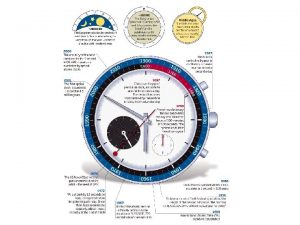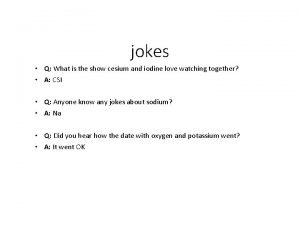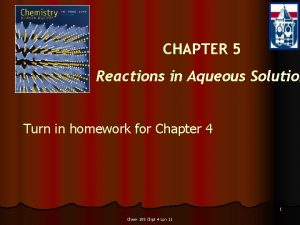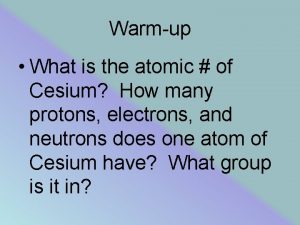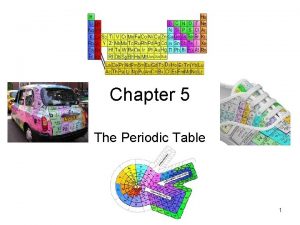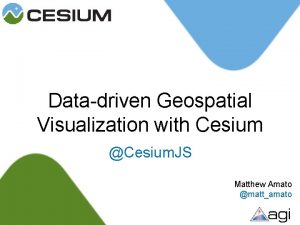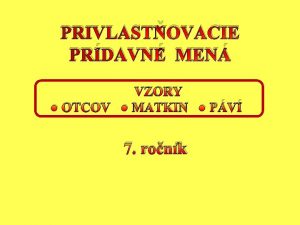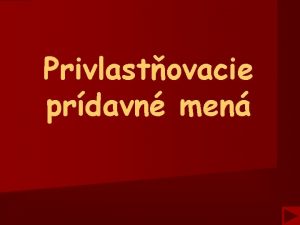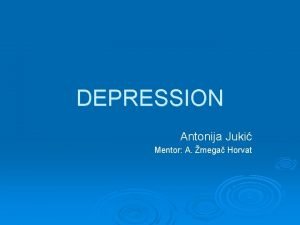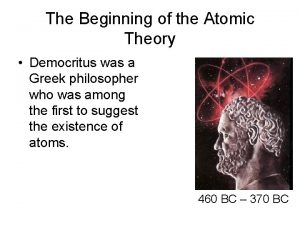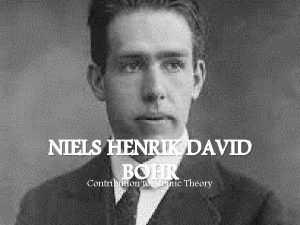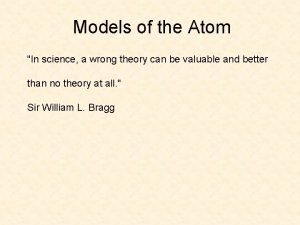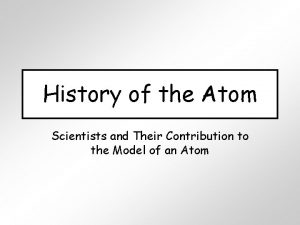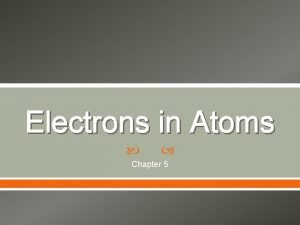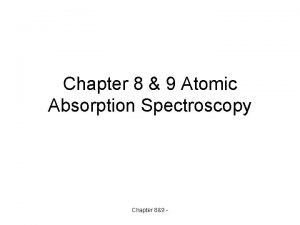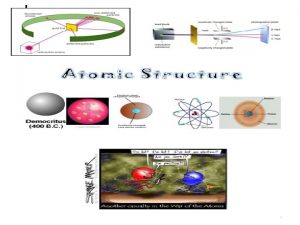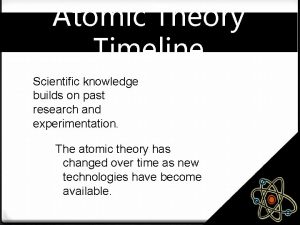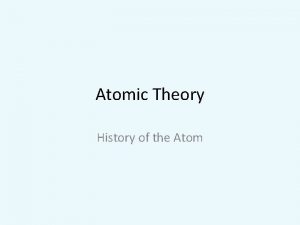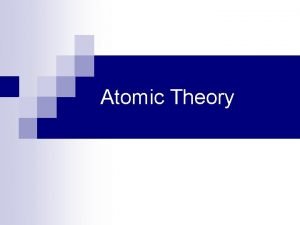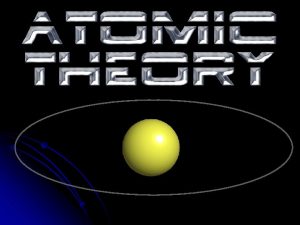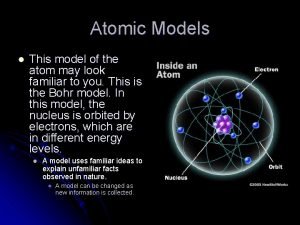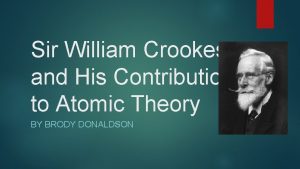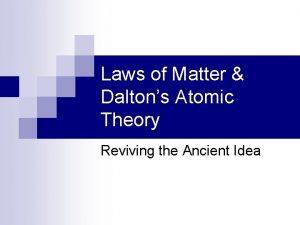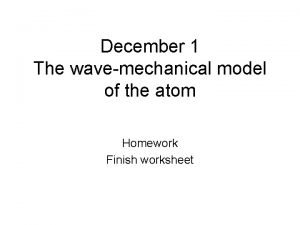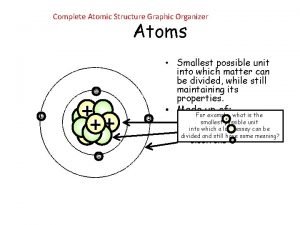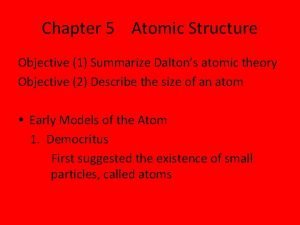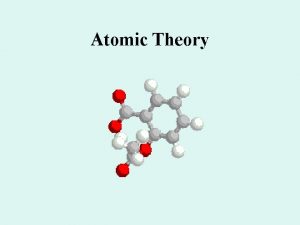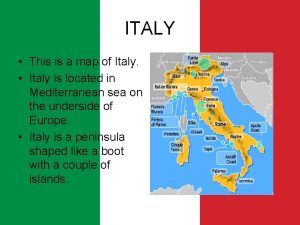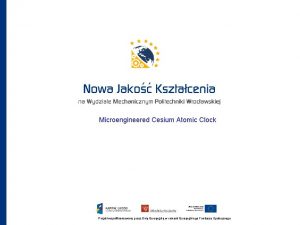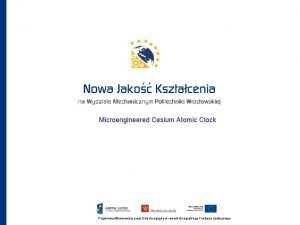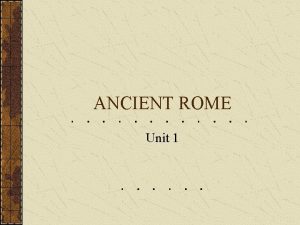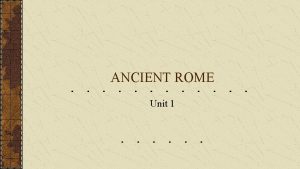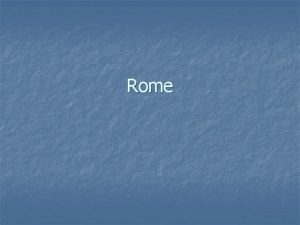PAVI 11 Rome Italy atomic theory in cesium



























![Cs PNC: Comparison with the standard model Standard Model [1] : Most current result Cs PNC: Comparison with the standard model Standard Model [1] : Most current result](https://slidetodoc.com/presentation_image/dff2a9ccf35de8469aaf3bb95aa0b0db/image-28.jpg)














- Slides: 42

PAVI 11 -Rome, Italy atomic theory in cesium, implications for searches for physics beyond the sm marianna safronova September 5, 2011

Atomic Parity Violation High energies Instead of search for new processes or particles directly Determine weak charge QW from atomic parity violation studies and compare the result with Standard Model prediction Low energies http: //public. web. cern. ch/, Cs experiment, University of Colorado

Two sides of the atomic parity violation nuclear spin-independent pnc: searches for new physics beyond the standard model e q e Z 0 q Weak Charge QW nuclear spin-dependent pnc: study of pnc in the nucleus a Nuclear anapole moment

experimental pnc studies

Cesium: atom with single (valence) electron outside a closed core. Need heavy atom for atomic PNC Cs Z=55 core 1 s 2 … 5 p 6 6 s valence electron Cs 7 s E 1 6 s l=0 to l=0 electric dipole transition is forbidden by parity selection rules

Atomic Parity Violation r ─r Cs 7 s Non-zero transition amplitude PNC amplitude EPNC E 1 6 s e e q Z 0 Both 6 s and 7 s states acquire an opposite-parity (np 1/2 ) admixture Z 0 exchange: Laporte’s rule is violated! q

Atomic Parity Violation r ─r Cs 7 s Non-zero transition amplitude PNC amplitude EPNC E 1 6 s e e q Z 0 Both 6 s and 7 s states acquire an opposite-parity (np 1/2 ) admixture Z 0 exchange: Laporte’s rule is violated! q Note: it is really tiny effect !!! EPNC ~10 -11 atomic units E 1 amplitude for 6 s – 6 p transition is 4. 5 atomic units

The most precise measurement of PNC amplitude ( cesium ) C. S. Wood et al. Science 275, 1759 (1997) F=4 F= 3 7 s 1 6 s 2 F=4 F= 3 0. 35% accuracy Stark interference scheme to measure ratio of the PNC amplitude and the Stark-induced amplitude b 1 2

Analysis of Cs PNC experiment nuclear spin-independent pnc 7 s nuclear spin-dependent pnc F=4 F= 3 7 s 1 6 s Average of 1 & 2 Weak Charge QW 2 6 s Difference of 1 & 2 F=4 F= 3 Nuclear anapole moment

Analysis of Cs PNC experiment nuclear spin-independent pnc 7 s 6 s Average of 1 & 2 Weak Charge QW

How to extract weak charge Qw from Cs experiment? e e q Z 0 Electron-quark parity violating interaction (exchange of virtual Z 0 boson) q Neutron density function Electronic sector: Extraction of weak the charge: Measured value Theoretical calculation of PNC amplitude

Calculation of PNC amplitude 1. Main part – Coulomb interactions Electric-dipole matrix elements Energies PNC matrix elements Sum is separated to main part, n = 6 - 9 and the tail 2. Other small corrections: Breit, QED, Neutron skin, e – e weak interaction

1989 – 2003: Summary of the PNC calculations -0. 902, -0. 908 (-0. 905 average) Blundell et al. (1992) -0. 908 Dzuba et al. (1989) -0. 909 Safronova & Johnson (1999) -0. 905 Kozlov et al. (2001) -0. 908 Dzuba et al. (2002) 0. 5% uncertainty Units: -0. 6% Breit correction -0. 2(1)% neutron skin correction +0. 4% vacuum polarization -0. 8% radiative corrections (Several works for all corrections)

Determination of QW : 1997 - 2003 Wood et al. (1997) Bennett & Wieman (1999) Measurement of b Derevianko (2000, 2002) Calculation of Breit correction Dzuba et al. (2000) Calculation of Breit correction Kozlov et al. (2001) Calculation of E PNC , Breit correction expt(89) theor -72. 61(29) expt(34/73) -72. 42(29) expt(74) theor -72. 5(7) 1. 5 s/no deviation expt(34/74) theor 2. 2 s/1. 2 s 2. 2 s b 1. 1 s -72. 65(49) Flambaum & Kuchiev (2002) (36) th expt (36) th Milstein et al. (2003) self-energy & vertex corr. -72. 81(29) expt E PNC 1. 3 s/0. 7 s theor -72. 16(29) -72. 71(29) Dzuba et al. (2002) 1 s 2. 5 s expt(34) theor -72. 12(29) Johnson et al. (2001) Calculation of vacuum pol. corr. Milstein & Sushkov (2002) Calculation of vacuum pol. corr. Vasilyev et al. (2002) Measurement of 6 s-7 p trans. , -72. 11(29) -72. 06(29) expt (36) th 2 s no deviation 0. 6 s

reducing theory uncertainty: why is it so difficult? Exact wave function Cs: 55 electrons Dirac-Hartree-Fock wave function (lowest order) Many-body operator, describes excitations from lowest-order 55 -fold excitations to get exact wave function Even for 100 function basis set 10055 Approximate methods: perturbation theory does not converge well, Need to use all-order methods (coupled-cluster method and correlation potential method)

Coupled-cluster method ( CCSD ) DHF wave function CCSD single-double coupled-cluster LCCSD coupled-cluster core excitation valence excitation core excitations core - valence excitations

Actual implementation: problem 1 There are some many equations! Need very accurate (large) basis sets for parity violation. Cs: a, b = 1 s 22 p 63 s 23 p 63 d 104 s 24 p 64 d 105 s 25 p 6 m, n : finite basis set = (35 13) Total actually 15412 35 ~ 19 000 equations to be solved iteratively! Our implementation of the coupled-cluster is different from quantum chemistry – new sets of codes were developed.

Actual implementation: problem 2 These are really complicated equations !!! a, b core • “Quadruple” term: (17 shells) Indices mnrs can be ANY orbitals Basis set: n max =35, lmax =6 17 x( 35 x 13 ) 4 =5 x 10 12 ! • Program has to be exceptionally efficient!

How to improve accuracy of CCSD? 1. Add more terms to the all order wave-function Non-linear terms Triple excitations 2. Restore complete 4 th order for matrix elements

Non-linear terms Contract operators by Wick’s theorem

Non-linear terms Contract operators by Wick’s theorem 800 terms!

Codes that write formulas The derivation gets really complicated if you add triples and non-linear terms! Solution: develop analytical codes that do all the work for you! Input: ASCII input of terms of the type Output: final simplified formula in LATEX to be used in the all-order equation

Triple excitations core valence electron any excited orbital Problem 1: too many excitation coefficients Problem 2: increased complexity of equations .

Triple excitations Problem: too many excitation coefficients . Doubles: Cs: a, b = 1 s 22 p 63 s 23 p 63 d 104 s 24 p 64 d 105 s 25 p 6 m, n : finite basis set = (35 13) Smallest required basis set: Need total about 300 MB (+extra 150 MB file) Extra index r gives at least a factor (35 13) : over 130 GB! The complexity of the equations also increases.

Problem with all-order extensions: TOO MANY TERMS Solution: automated code generation ! Codes that write formulas Codes that write codes Input: Output: list of formulas to be programmed final code (need to be put into a main shell) Features: simple input, essentially just type in a formula!

Monovalent systems: very brief summary of what we calculated with all-order method Properties Systems • Energies • Transition matrix elements (E 1, E 2, E 3, M 1) Li, Na, Mg II, Al III, • Static and dynamic polarizabilities & applications Si IV, P V, S VI, K, Dipole (scalar and tensor) Ca II, In-like ions, Quadrupole, Octupole Ga, Ga-like ions, Rb, Light shifts Cs, Ba II, Tl, Fr, Th IV, Black-body radiation shifts U V, other Fr-like ions, Magic wavelengths Ra II • Hyperfine constants • C 3 and C 6 coefficients • Parity-nonconserving amplitudes (derived weak charge and anapole moment) • Isotope shifts (field shift and one-body part of specific mass shift) • Atomic quadrupole moments • Nuclear magnetic moment (Fr), from hyperfine data http: //www. physics. udel. edu/~msafrono

Summary of the PNC amplitude calculations Coulomb interaction Porsev et al. , PRL 102, 181601 (2009) Main part, n = 6 - 9 0. 8823(18) Tail 0. 0175(18) Total 0. 8998(25) Corrections Breit -0. 0054(5) Derevianko, PRL 85, 1618 (2000) QED -0. 0024(3) Shabaev et al. , PRL 94, 213002 (2005) Neutron skin -0. 0017(5) Derevianko, PRA 65, 012016 (2000) 0. 0003 Blundell et al. , PRL 65, 1411 (1990) e-e weak interactions Final Units: 0. 8906(26) Porsev et al. , PRL 102, 181601 (2009)
![Cs PNC Comparison with the standard model Standard Model 1 Most current result Cs PNC: Comparison with the standard model Standard Model [1] : Most current result](https://slidetodoc.com/presentation_image/dff2a9ccf35de8469aaf3bb95aa0b0db/image-28.jpg)
Cs PNC: Comparison with the standard model Standard Model [1] : Most current result for Cs PNC Expt/Theory: Atomic physics [2] : No deviation from the Standard Model [1] C. Amsler et al. (Partical Data Group), Phys. Lett. B 667, 1 (2008) [2] S. G. Porsev, K. Beloy and A. Derevianko, PRL 102, 181601 (2009), Phys. Rev. D 82, 036008 (2010)

implications for particle physics

Confirms fundamental “running” (energy dependence) of the electroweak force over energy span 10 Me. V 100 Ge. V Adopted from Czarnecki & Marciano, Nature (2005)

Probing new physics New physics can be phenomenologically described by weak isospin - conserving S and isospin - breaking T parameters [1]. Present result [2]: Parameter S is important for indirect constraint on the mass of Higgs particle [1] J. L. Rosner, PRD 65, 073026 (2002) [2] S. G. Porsev, K. Beloy and A. Derevianko, PRL 102, 181601 (2009), Phys. Rev. D 82, 036008 (2010)

Probing new physics: extra Z bosons e e q Z 0 e q + q e Z’ q Atomic parity violation is uniquely sensitive to Z’ Z’χ in SO(10) GUT, Marciano & Rosner

Probing new physics: extra Z bosons Z’χ in SO(10) GUT, Marciano & Rosner Cs result [1] implies Direct search at Tevatron collider [2] [1] S. G. Porsev, K. Beloy and A. Derevianko, PRL 102, 181601 (2009) [2] T. Aaltonen et al. , Phys. Rev. Lett. 99, 171802 (2007)

Parity violation in atoms nuclear spin-dependent pnc: study of pnc in the nucleus The other part of the story a Nuclear anapole moment

Spin-dependent parity violation: Nuclear anapole moment a Parity-violating nuclear moment F=4 F= 3 7 s 1 6 s 2 F=4 F= 3 Anapole moment Nuclear anapole moment is parity-odd, time-reversal-even E 1 moment of the electromagnetic current operator. Valence nucleon density

Constraints on nuclear weak coupling contants W. C. Haxton and C. E. Wieman, Ann. Rev. Nucl. Part. Sci. 51, 261 (2001)

Nuclear anapole moment? The constraints obtained from the Cs experiment were found to be inconsistent with constraints from other nuclear PNC measurements, which favor a smaller value of the 133 Cs anapole moment. k Possible atomic calculation solution? = 0. 117(16) Incomplete correlation calculation of spin-dependent PNC amplitude?

More spin-dependent PNC effects (V e , A N ) interaction Same Hamiltonian as anapole moment term with W. R. Johnson, M. S. 062106 (2003) Weak-hyperfine interference term This term does not reduce to the same interaction but “effective” constant can be calculated. Safronova and U. I. Safronova , Phys. Rev. A 67,

New all-order (CCSD) calculation of spin-dependent PNC Electric-dipole matrix elements PNC matrix elements First four terms in the sums are replaced by all-order matrix elements 1% accuracy is expected

Nuclear anapole moment: Test of hadronic weak interations The constraints obtained from the Cs experiment were found to be inconsistent with constraints from other nuclear PNC measurements, which favor a smaller value of the 133 Cs anapole moment. All-order (LCCSD) calculation of spin-dependent PNC amplitude: k = 0. 107(16)* [ 1% theory accuracy ] No significant difference with previous value k = 0. 112(16) is found. NEED NEW EXPERIMENTS!!! Fr, Yb, Ra+ *M. S. Safronova, Rupsi Pal, Dansha Jiang, M. G. Kozlov, W. R. Johnson, and U. I. Safronova, Nuclear Physics A 827 (2009) 411 c

Conclusion A: New analysis of atomic PNC experiment is Cs: Nuclear spin-independent part: (1) Provided most accurate to-date test of the low-energy electroweak sector of the SM. (2) Confirmed fundamental “running” (energy dependence) of the electroweak force. (3) Placed constraints are on a variety of new physics scenarios beyond the SM. B: New analysis of atomic PNC experiment is Cs: Nuclear spin-independent part (anapole moment) (1) New calculations, accurate to 1% - essentially the same result. (2) Constraints on nuclear weak coupling constants are still inconsistent with nuclear physics experiments.

need new experimental pnc ! D E studies T W N A
 Cesium fountain atomic clock
Cesium fountain atomic clock Relative location of rome italy
Relative location of rome italy The geography of rome
The geography of rome Horizontal
Horizontal What is an ion
What is an ion Iron(iii) chloride (aq) + cesium phosphate (aq)
Iron(iii) chloride (aq) + cesium phosphate (aq) How many protons does cesium have
How many protons does cesium have Noble gas period 6
Noble gas period 6 Cesium java
Cesium java O bratových spolužiakoch
O bratových spolužiakoch Vzor otcov
Vzor otcov Manuela pavi wikipedia
Manuela pavi wikipedia Přástevník medvědí housenka
Přástevník medvědí housenka Relative formula mass of hcl
Relative formula mass of hcl Periodic table with trends
Periodic table with trends Atomic radius on periodic table
Atomic radius on periodic table Atomic weight of oxygen
Atomic weight of oxygen Difference between atomic mass and atomic number
Difference between atomic mass and atomic number Atomic number vs atomic radius
Atomic number vs atomic radius Club of rome theory
Club of rome theory 460 democritus atom model
460 democritus atom modelSir james chadwick atomic theory
 Democritus atomic theory date
Democritus atomic theory date Neil bohr contribution to atomic theory
Neil bohr contribution to atomic theory Quantum mechanical atomic model
Quantum mechanical atomic model Erwin schrödinger contribution to atomic theory
Erwin schrödinger contribution to atomic theory Atomic theory timeline
Atomic theory timeline Dalton atomic theory summary
Dalton atomic theory summary Total consumption burner
Total consumption burner Bc atomic mass
Bc atomic mass Scientific theory timeline
Scientific theory timeline Atomic models timeline
Atomic models timeline Father of atomic theory
Father of atomic theory คืออะไร
คืออะไร Erwin schrödinger atomic theory
Erwin schrödinger atomic theory Atomic molecular theory
Atomic molecular theory Sir james chadwick atomic theory
Sir james chadwick atomic theory William crookes atomic theory date
William crookes atomic theory date Dalton's atomic theory was accepted because
Dalton's atomic theory was accepted because Erwin schrödinger atomic theory
Erwin schrödinger atomic theory Atomic structure
Atomic structure Summarize dalton's atomic theory
Summarize dalton's atomic theory History of the atom graphic organizer
History of the atom graphic organizer
